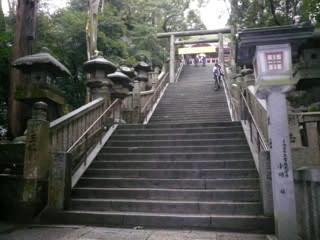I walked "the Yamanobe-no-michi (山の辺の道)" in Nara. They say it is one of the oldest national roads.
Its name is found in the oldest Japanese historical writing completed in the early 8th century.
Though the overall distance of the road that stretches from the heart of Nara to Sakurai is about 30 kilometers, I walked the southern half that is the most popular part.

(Above: Isonokami shrine)
The starting point of the road is "Isonokami shrine" in Tenri city. The shrine is one of the oldest shrines in Japan.

(Above: The southern Yamanobe-no-michi starts at Isonokami shrine)
In fact, there are a lot of "the oldest something" along the Yamanobe-no-michi.

(Above: Old "Yatogi shrine" with the straw-thatched roof"
The road, actually the path, runs down through agricultural scenery dotted with small hills covered with lush greenery, old shrines and reservoirs.

(Above: Reservoir at the remains of an old famous temple)

(Above: Old community surrounded by a moat)

(Above: Stone monument of an ancient tanka poet)

(Above: The Gate of Chogaku-ji temple. It is the oldest bell tower in Japan)

(Above: The garden of Chogaku-ji)
At first sight, it looks like typical scenery of the countryside in Japan, however, the mounds aren't ordinary ones. They are the ancient tombs (including the first Emperor's tumulus built in the 4th century). Here is the cradle of the ancient Japanese dynasty.

(Above: The Fusumada tumulus which is 140 meters long)

(Above: One of the biggest tumulus built in the 4th century)
Passing through the groves of persimmon and mandarin orange, I saw an elegant mountain beyond the spacious field. It is "Mt. Miwa", the goal of this hike.

(Above: The View of Mt. Miwa)
The mountain has been the object of worship since ancient times. Ancient Japanese people used to have an intimacy with nature and believe that gods reside throughout all nature.
So the shrines at the foot of Mt. Miwa don't have the main sanctuary expressing such ideas: the sanctuary is the mountain itself.

(Above: Hibara shrine. There are only Torii gate at the foot of the mountain)


(Above: Omiwa shrine (大神神社), which is the goal of the Yamanobe-no-michi)
I love walking along ancient roads. I find there the memories of the land. At the end of today's hike, I ate "somen", one of the Japanese noodles. Somen is a speciality of this area.
※ From Tenri station (JR or Kintetsu line) to Isonokami shrine= 30 minutes on foot or 7 minutes by taxi
From Omiwa shrine to Sakurai station (JR or Kintetsu line)=10 minutes by bus











































